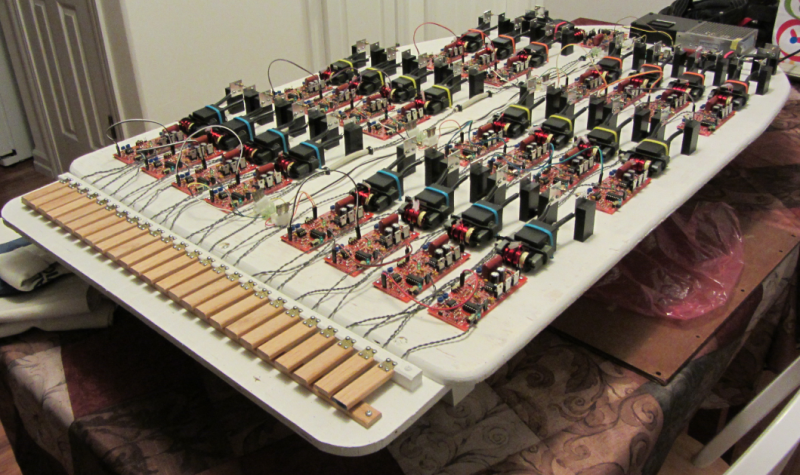[Matt] works at a neon sign power supply company. When a vendor error left him with quite a few defective high voltage transformers, he couldn’t bring himself to toss them in the bin. [Matt] was able to fix the transformers well enough to work, and the idea for a high voltage keyboard began to brew. Unfortunately, the original transformers were not up to the task of creating a musical arc. At that point the project had taken on a life of its own. Matt grabbed some higher power transformers and started building.
The keyboard has 25 keys, each connected to an individual high voltage circuit with its own spark gap. The HV circuit is based upon a IR2153D self-oscillating half-bridge driver. (PDF link). The 2153D is modulated by a good old-fashioned 555 timer chip. No micros in this design, folks! The output of the IR2153D switches a pair of N-channel MOSFETS which drive the flyback transformers.
[Matt] created 25 copies of his circuit and built them up on individual PCBs. He assembled everything on a wooden board shaped roughly like a grand piano. The final project looks great – though [Matt] admittedly has no musical ability, so we can’t hear AC/DC flying out of those spark gaps just yet.
If you do want to hear sparks playing music, check out the OneTesla project we saw at MakerFaire NY 2013.















this is amazing
I was hoping to hear “Ozone Baby” by LED Zepplin.
Fantastic project, great execution.
It’ll be a great accompaniment to the high pitched screams from the Ham operators living near him.
What do you mean “near”!
Without an intentional antenna, my guess would be effectively jamming things up to 250 meters away. Could be up to 500 meters or more. Past that point I’d think he’d be trashing the wavelengths to frustrate a lot of the DX’ers out there.
What, no Arduino?
Neat, can smell the ozone!
I can see that he lacks musical talent, but unfortunately also hasn’t thought about a potential keyboardist. The notes don’t sound chromatic properly and the keys are linearly arranged, instead of WBWBWWBWBWBW (White/Black).
He has put a bunch of effort into this, and I am very impressed. However, I can’t see why 25 transformers are needed to play 25 notes… Surely a 555 on each key could send pulses to one central flyback/driver combo? Much cheaper and more replicable. Maybe playing multiple notes at once sounds much cooler with this setup?
Why build a spark-gap piano at all? Fun! I’m sure it could have been done with a single transformer, maybe five or so for five simultaneous notes, but this is a badass use for 25 spare transformers.
I wibbled a bit when he plays a note then reaches out and casually adjusts the spark gap.
That was the best! the only thing missing was a “Warning high voltage is dangerous” leader to the video. That would make it complete. Just hope (for his sake) there never will be a bloopers video.
Anyways fun project.
good idea, I should have put a “disclaimer” at the beginning. No blooper reel, you get bit by a neon transformer once or twice, you tend to be a little more mindful.
The HV warning at the begining is a good idea. No bloopers, you get bit once or twice by a neon power supply, you tend to remember it.
so again… If you’re doing a build of a musical instrument, perhaps you should find someone to play some actual music on it.
What concerned me the most was when he played all the keys at the end of the video. What is the max current if all keys are played at the same time? how is it powered? can it handle that much current